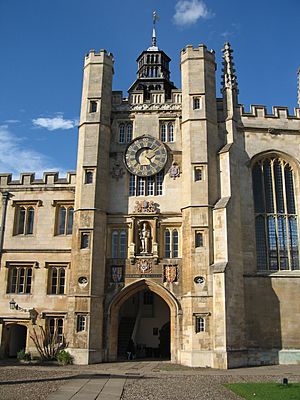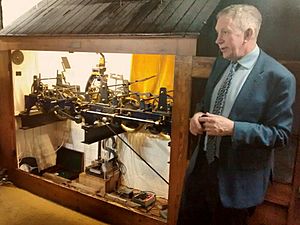Trinity College Clock facts for kids
The Trinity College Clock is a very old and important clock. You can find it at Trinity College, Cambridge, which is a famous university in England. This clock is not just for telling time; it has a long and interesting history and a special way of chiming!
The Story of the Trinity College Clock
The clock tower is part of King Edward's Gate, located in the Trinity Great Court. This gate is one of the oldest buildings at the college. The very first clock was put there in 1610 by a person named Thomas Tennant from London.
The original bell from that first clock is still there today! It has a special message carved into it. The message says: "TRINITAS IN UNITATE RESONAT 1610. RICARDUS HOLD FELD ME FECIT." This means "Trinity Resounds in Unity 1610. Richard Holdfeld Made Me."
In 1726 and 1727, the old clock's inner workings were given to the village of Orwell, Cambridgeshire. The head of the college at that time, Richard Bentley, provided a brand new clock, a new clock face, and three new bells for Trinity College. This clock became famous for a special reason: it strikes the hour twice! First, it makes a low sound, which is called the 'Trinity' chime. Then, it makes a higher sound, known as the 'St John's' chime.
Later, in 1910, this 18th-century clock was replaced again. A company called Smith of Derby built the new clock. It was designed by a person named Lord Grimthorpe.
The clock we see today is very special. It uses a pendulum that is 2 meters long and can keep time incredibly well. It can stay accurate to within one second for a whole month without needing any adjustments!
Keeping an Eye on the Clock
The Trinity College Clock is currently part of an interesting project. Dr. Hugh Hunt, who is a Fellow at Trinity College Cambridge, is leading this work. He is carefully checking the clock's accuracy.
Dr. Hunt and his team are comparing the clock's time to the official time signal from the National Physical Laboratory. They are also looking at other things that might affect how well the clock keeps time. These include how much the pendulum swings, the amount of moisture in the air (humidity), the air temperature, the air pressure, and even how thick the air is (air density). This project helps them understand exactly how the clock works and how accurate it truly is.



